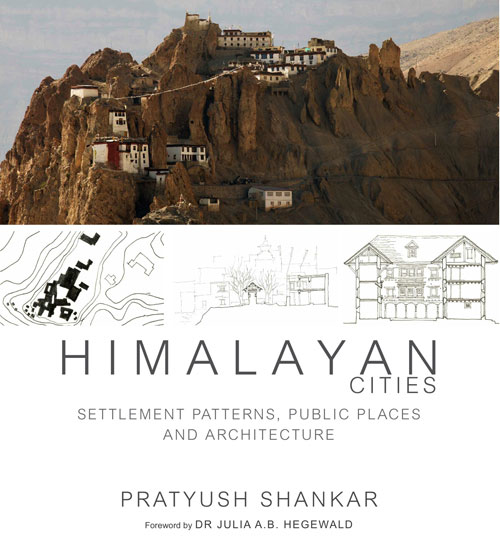|
|
The South
Asian Life & Times - SALT |
|
|||
|
Contents Feature Heritage People
Book Reviews Kaavad
Traditions of Rajasthan
- exploring
|
|
||||
|
HIMALAYAN CITIES
Settlement Patterns, Public Places and Architecture
By Pratyush Shankar
Hardcover. Illustrated.
216pp.
Niyogi
Books, 2014
₹2995 / £50 / $90
Reviewed by Anita Yadav
Himalayan Cities - Settlement Patterns, Public
Places and Architecture by Pratyush Shankar fulfils a much awaited
requirement of such a book. Scholars of various hues have brought out
beautifully illustrated and researched books on architecture in the
Himalayan communities, sustainable development, natural beauty and tourism.
Pratyush Shankar has brought together all these perspectives to study
settlement patterns in Himalayan cities. Scholars have often highlighted the
need of research in this field. . Dr Julia .B. Hegewald, Professor of
Oriental Art History at the University of Bonn has written the Foreword to
this book. She has aptly written, ”This seminal monograph presents a
radically new and distinct approach to studying the built environment of the
Himalaya. In comparison to other studies,
Himalayan Cities, Settlement
Patterns, Public Places and Architecture by Pratyush Shankar takes a
much broader approach on a number of levels.
At a panel discussion on Himalayan Studies at Yale University in March 2013
it was concluded that the Himalaya have been invoked as an analytical
category by various researchers from scientific, social scientific,
humanities and applied backgrounds. Himalayan framing has long served as a
valuable tool for understanding the sweep of histories, societies and
environment that connect the region. The danger with this is that regional
specificities may suffer under such a broad reference framework. Pratyush
strikes a fine balance between a trans Himalayan study and local
specificities.
In this book Pratyush studies cities as architectural, spatial settlements,
cultural expressions, economic zones, nodal centres of change and ecological
impact against the backdrop of the Himalayan landscape. Pratyush devotes an
entire chapter to the landscape and its mythological, cultural, economic and
socio-political dynamics. He draws an interesting parallel with the Greek
City States .He then takes this comparative approach to a higher level to
highlight nature-city interaction, nature - city relation and their
outcomes. Pratyush attempts a very interesting broad comparative bandwidth
by juxtaposing Egyptian, Greek, Roman, Judaeo-Christian, Hindu and Buddhist
cultures. While attempting this sweeping bird’s eye view Pratyush ensures
that local specificities do not get submerged.
For Pratyush, Himalayan cities are not exotic Shangri Las but dynamic
entities. As an architect he discusses how the Himalayan cities with their
immense historical legacy of built environment transform to accommodate
changed realities so that new architectural and urban symbols will get
created in the process. He stresses “the real challenge to urban planners is
how to integrate these cities into modern flow of things and thereby create
something of enduring value correctly fitting and consistent with
aspirations of the people.”
The chapter titled “Appropriate Landscape” is the longest. Here Pratyush
extensively discusses expression of human interaction with the landscape in
various forms from public and private courtyards, castle-temples,
monasteries, modern housing clusters of Kathmandu to the colonial grandeur
of Shimla.
Pratyush Shankar draws an interesting and
important
connection between movement of water and
the form of the city and describes ”not only the city centre alone but
spaces of everyday living such as small shrines, steps around a water body,
water fountains, and temples.”
Pratyush Shankar’s book is an outcome of extensive field research, reference
to a wide body of writings on various aspects of the Himalayas, and years of
work done by him as a practising architect and as an Associate Professor at
the Faculty of Architecture at CEPT University, Ahmedabad. Pratyush’s
scholarship and his love for the Himalaya, as evident in the writing style
and presentation of the book, saves it from becoming another scholarly tome.
It is a book which is truly enjoyable.
|
|||||
|
Copyright © 2000 - 2015 [the-south-asian.com]. Intellectual Property. All rights reserved. |
|||||
